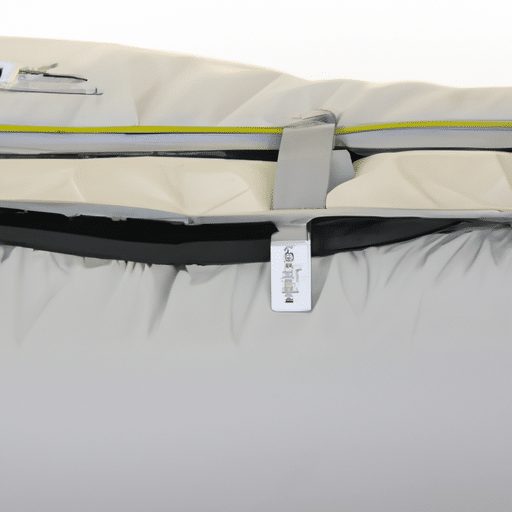Here’s a simple guide to help you keep your SUP board safe from any potential damage during transport and storage. Whether you’re a seasoned paddler or just starting out, we know how important it is to maintain the integrity of your board. From investing in proper board bags to storing it in the right conditions, we’ve got you covered. Read on to discover some practical tips and tricks that will ensure your board stays in pristine condition, ready to hit the water whenever you are.
Choosing the Right SUP Board Bag
When it comes to choosing the right SUP board bag, there are a few important factors to consider. One of the first things to think about is the size and shape of your board. You want to make sure that the bag you choose is the right fit for your board. A bag that is too big can allow your board to shift around during transport, potentially causing damage. On the other hand, a bag that is too small may not provide adequate protection.
In addition to size, you should also look for a bag with good padding and cushioning. This is especially important if you plan on traveling long distances or if you’re going to be using public transportation. The padding and cushioning will help absorb any bumps or jolts that your board may encounter during transport. This can help prevent damage to your board and ensure that it arrives at your destination in good condition.
Another important consideration is the exterior material of the bag. You’ll want to choose a bag that has a durable exterior material that can withstand the rigors of travel. Look for bags made from materials like nylon or polyester that are known for their strength and durability. A bag with a durable exterior material will provide an additional layer of protection for your board.
Lastly, consider any additional features that may be beneficial to you. Some bags come equipped with wheels, making it easier to transport your board through airports or parking lots. Others may have backpack straps, allowing you to carry your board on your back for hands-free convenience. Think about your specific needs and preferences when it comes to additional features, and choose a bag that aligns with them.
Properly Packing Your SUP Board
When packing your SUP board, it’s important to take a few steps to ensure that it stays safe and secure during transport. The first thing you should do is clean and dry your board before packing it away. This will help prevent any dirt or debris from causing scratches or damage to your board during transit.
Next, remove any fins or accessories from your board. Fins can be fragile and are prone to breaking if they’re not properly protected. Removing them before packing your board will help prevent any damage to both the fins themselves and your board.
To provide an extra layer of protection, consider wrapping your board in bubble wrap or towels. This will help cushion it and prevent any unnecessary movement while it’s inside the bag. Be sure to secure the bubble wrap or towels in place with tape or straps to ensure they don’t shift during transit.
It’s also important to properly secure your paddle and leash. You can use Velcro straps or bungee cords to keep them in place and prevent them from moving around or getting tangled. This will help minimize the risk of any damage to your paddle or leash, as well as your board.
When placing your board inside the bag, do so with care. Make sure it’s centered and aligned properly so that it fits snugly and doesn’t move around during transport. This will help prevent any unnecessary wear and tear on your board.
Transporting the SUP Board Safely
Transporting your SUP board safely is crucial to prevent any damage during transit. There are a few key steps you should follow to ensure the safe transportation of your board.
First and foremost, it’s important to ensure secure attachment to your vehicle. Use proper roof racks or straps specifically designed for transporting SUP boards. Securely attach your board to your vehicle to prevent it from shifting or falling off during travel.
Use proper straps and tie-downs to secure your board to your vehicle. These should be adjustable and strong enough to keep your board in place, even during sudden stops or turns. Be sure to follow the manufacturer’s recommendations for securing your board, as different boards may require different methods.
When driving with your SUP board, it’s important to avoid excessive speeds and rough roads. Higher speeds can cause unnecessary stress on your board, while rough roads can lead to bumps and jolts that may damage your board. Be mindful of the road conditions and adjust your driving accordingly to minimize any potential damage.
During transit, periodically check on your board to ensure it’s still securely in place and hasn’t shifted. This is especially important during long-distance travels where you may encounter different road conditions. Taking a few moments to inspect your board can help catch any issues before they become bigger problems.
Lastly, protect your board from sun and heat exposure. Prolonged exposure to intense sunlight and high temperatures can cause your board to warp or delaminate. Whenever possible, park your vehicle in shaded areas or cover your board with a board bag or reflective cover to shield it from the sun’s rays.
Storing Your SUP Board
Properly storing your SUP board when it’s not in use is essential to maintaining its condition and prolonging its lifespan. Follow these steps to ensure your board stays in good shape while in storage.
Choose a suitable storage location for your board. This should be a place that is dry, clean, and free from extreme temperatures. Avoid areas with direct sunlight or high humidity, as these can both negatively impact the integrity of your board.
When storing your board, consider using rack systems or wall mounts for support. These will help keep your board elevated and off the ground, reducing the risk of accidental damage. Look for racks or mounts specifically designed for SUP boards, as they will provide the best support and stability.
Store your board in an upright position whenever possible. This will help maintain its shape and prevent warping or bending. If you don’t have the space to store your board upright, consider using foam pads or cushions to support it horizontally, but ensure that it is still stable and not prone to falling or shifting.
Regularly inspect and maintain your board while it’s in storage. Check for any signs of damage or wear, such as cracks, dings, or delamination. If you notice any issues, repair them promptly to prevent further damage. Additionally, clean your board regularly to remove any dirt or debris that may have accumulated during storage.
Taking Care of the Board’s Fin
The fin is an important component of your SUP board, and proper care and maintenance are essential to ensure its longevity and performance. Follow these steps to take care of your board’s fin.
Before transporting or storing your board, it’s important to remove the fin. Fins are often delicate and can be easily damaged if left in place during transport or storage. Removing the fin will help protect it and ensure it remains in good condition.
Clean and dry the fin properly before packing it away. Use fresh water to rinse off any salt or dirt that may have accumulated. After rinsing, let the fin air dry completely to prevent any moisture from causing corrosion or damage.
To provide added protection, consider applying wax or fin guard to your fin. These products can help create a barrier against scratches and damage, as well as protect the fin from the effects of prolonged exposure to water and sunlight.
Regularly inspect the fin for any signs of wear or damage. Look for cracks, chips, or any abnormalities that may affect its performance. If you notice any issues, consider having the fin professionally repaired or replaced to ensure optimal performance.
When storing the fin, make sure to do so safely and securely. Keep it in a location where it won’t be easily knocked over or damaged. Avoid resting heavy objects on top of the fin, as this can cause unnecessary stress and potentially lead to damage.
Protecting the SUP Board from Impact
Impact damage can easily occur if you’re not careful when handling your SUP board. To prevent impact damage, follow these guidelines:
Avoid dropping or bumping the board whenever possible. Dropping the board can cause cracks or dings, while bumping it against hard surfaces can lead to scratches or gouges. Handle your board with care, being mindful of its weight and size.
Do not rest heavy objects on top of the board. Your board is designed to support your weight while on the water, but placing heavy objects on top of it can cause unnecessary stress and potentially lead to damage. Avoid using your board as a storage surface or sitting on it when it’s not in the water.
Consider using edge guards or nose protectors. These accessories can provide extra protection to vulnerable areas of your board. Edge guards can help prevent scratches and dings to the sides of your board, while nose protectors can shield the front of your board from impact damage.
Handle your board with caution, especially when navigating tight spaces or crowded areas. Be aware of your surroundings and take extra care to avoid accidentally hitting walls, doorframes, or other people. A little caution can go a long way in preventing unnecessary impact damage.
Avoid contact with sharp objects. Whether it’s rocks, coral reefs, or even the edge of a car trunk, sharp objects can easily damage your SUP board if it comes into contact with them. Be mindful of your surroundings and make sure to steer clear of any potential hazards.
Preventing Damage from Water Exposure
Water exposure can be detrimental to the health and integrity of your SUP board. To prevent damage from water exposure, follow these steps:
Avoid prolonged exposure to saltwater or chlorinated water. While your board is designed to handle water, extended exposure to saltwater or chlorinated water can cause corrosion or damage to the materials. Rinse your board with fresh water after each use to remove any salt or chemicals.
Thoroughly rinse and dry your board after each use. Use a hose or bucket of fresh water to rinse off any salt or dirt that may have accumulated on your board. After rinsing, let your board air dry completely before storing it. This will help prevent any moisture from causing damage or corrosion.
Regularly inspect your board for signs of water damage or delamination. Look for soft spots, discoloration, or any abnormalities that may indicate water has penetrated the board. If you notice any issues, have your board professionally inspected or repaired to prevent further damage.
Apply UV protectant to prevent fading or discoloration. Prolonged exposure to the sun’s UV rays can cause your board’s colors to fade or become discolored over time. Use a UV protectant specifically designed for SUP boards to help preserve the vibrancy and integrity of your board’s colors.
When not in use, consider using a board bag or cover to protect your board from water exposure. A board bag or cover can help shield your board from rain, splashes, and dew that may accumulate overnight. This added layer of protection can go a long way in preserving the quality of your board.
Maintaining Proper Inflation and Deflation
Maintaining proper inflation and deflation of your SUP board is key to its performance and longevity. Follow these steps to ensure you’re taking proper care of your board.
Follow the manufacturer’s guidelines for inflation. Every board is unique, and the recommended PSI (pounds per square inch) may vary. Refer to your board’s user manual or the manufacturer’s website for specific inflation instructions. Proper inflation will ensure your board is rigid and ready for use.
Avoid overinflating or underinflating your board. Overinflating can put unnecessary stress on the seams and material, potentially causing damage. Underinflating can result in poor performance and instability. Use a reliable pressure gauge to ensure your board is inflated to the recommended PSI.
Release air pressure when your board is not in use or during extreme temperature changes. Fluctuations in temperature can cause the air pressure inside your board to change. This can potentially lead to damage or compromise your board’s performance. Release air pressure when you’re not using your board or if you’ll be exposing it to extreme temperature changes.
Ensure all valves are securely closed before inflating your board. Leaks can occur if valves are not properly closed, resulting in a loss of air pressure and potential damage to your board. Take the time to double-check that all valves are tightly closed before inflating your board.
Regularly inspect your board for leaks or damaged valves. Before each use, visually inspect your board for any signs of air leakage or damage to the valves. If you notice any issues, have them repaired promptly to prevent further damage or performance issues.
Protecting the SUP Board from Extreme Temperatures
Extreme temperatures can have detrimental effects on your SUP board. To protect your board from these conditions, follow these steps:
Avoid leaving your board in hot or freezing conditions for extended periods of time. High temperatures can cause the materials of your board to warp or delaminate, while freezing temperatures can lead to cracks or damage. Whenever possible, store your board in a climate-controlled environment to avoid extreme temperature exposure.
Store your board in a climate-controlled environment. If you live in an area with extreme temperatures, consider storing your board indoors where the temperature can be regulated. This will help protect your board from the damaging effects of intense heat or cold.
Allow your board to gradually adjust to temperature changes. Rapid temperature shifts can cause stress on the materials of your board, potentially leading to damage. When transitioning your board from one temperature extreme to another, allow it to gradually adjust by leaving it in a moderate temperature environment for a period of time.
Avoid sudden temperature shifts. Be mindful of where you store or transport your board to minimize exposure to rapid temperature changes. For example, avoid placing a cold board directly into a hot car trunk or vice versa. Taking steps to avoid sudden temperature shifts can help preserve the integrity of your board.
Consider using insulated covers or bags for additional protection. Insulated covers or bags can help regulate the temperature around your board, providing an extra layer of protection against extreme temperatures. Look for covers or bags specifically designed for SUP boards to ensure a proper fit.
Regular Board Maintenance and Inspections
Regular maintenance and inspections are crucial to keeping your SUP board in optimal condition. Follow these steps to ensure your board stays in top shape.
Clean your board properly after each use. Use fresh water and a mild detergent to remove any salt, dirt, or debris that may have accumulated on your board. Gently scrub with a soft brush or sponge, paying special attention to any stubborn areas. Rinse thoroughly and let your board air dry before storing it.
Inspect your board for cracks, dings, or delamination. Regularly inspect your board for any signs of damage that may have occurred during use or storage. Look for cracks along the seams, dings on the surface, or any abnormalities that may affect the performance of your board. Address any issues promptly to prevent further damage.
Repair any damages promptly. If you notice any cracks, dings, or delamination, it’s important to repair them promptly to prevent further damage. Follow the manufacturer’s recommendations for repairs or consult a professional if needed. Taking care of repairs in a timely manner will help maintain the integrity and performance of your board.
Apply wax or polish to maintain the board’s condition. Applying a coat of wax or polish to your board can help protect it from scratches and UV damage, as well as keep it looking clean and shiny. Follow the manufacturer’s instructions for the specific wax or polish you choose.
Replace old or worn-out parts. Over time, certain parts of your board may become worn out or damaged. This can include leash attachments, handles, or straps. Regularly inspect these parts and replace any that are showing signs of wear or are no longer functioning properly.
By following these steps, you can help prevent damage to your SUP board during transport and storage. Taking care of your board will not only extend its lifespan but also ensure that it performs at its best when you’re out on the water. So take the time to choose the right SUP board bag, pack your board properly, transport it safely, store it correctly, and maintain it regularly. With proper care and attention, your SUP board will be ready for many adventures to come. Happy paddling!





































